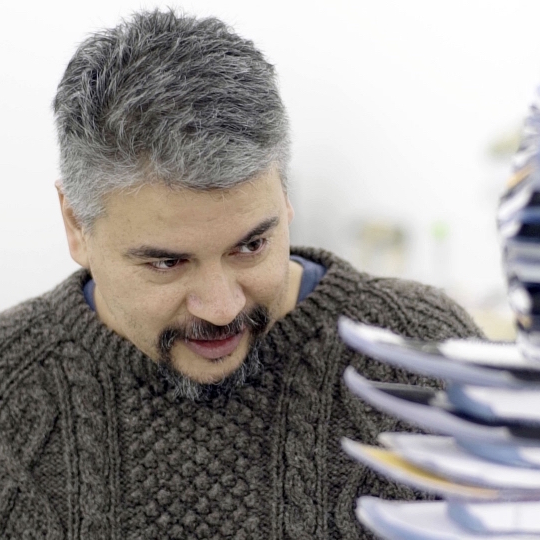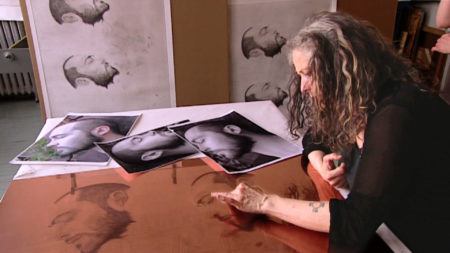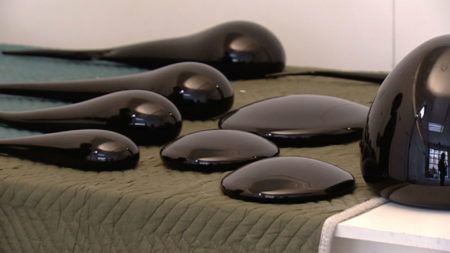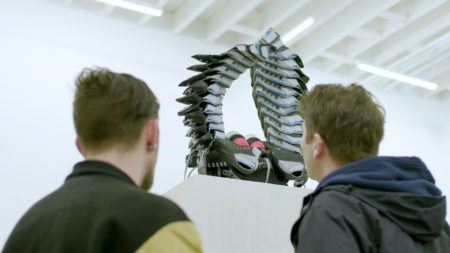Continue playing
(Time remaining: )
Play from beginning
Continue playing "{{ controller.videos[controller.getVideo(controller.currentVideo)].segmentParentTitle}}"
{{controller.videos[controller.getVideo(controller.currentVideo)].title}} has ended.
Printing Two PerspectivesBrian Jungen
Artist Brian Jungen creates two-sided prints from archival newspaper clippings, revealing the lens of otherness through which Native people are frequently viewed. “It was always about inequality but it wasn’t really from the Native person’s perspective,” says Jungen of the newspaper articles. “These are the stories I would have read as a kid and they would have made me feel really bad about being Native.”
By reproducing both sides of the clippings on corresponding sides of his prints, Jungen highlights the often disparate realities faced by Native and non-Native people. The artist draws from a strong tradition of printmaking in First Nations communities, especially those closer to the Arctic. Artists such as Kenojuak Ashevak employ bilateral symmetry to depict the duality of an image, and in the same way Jungen illustrates the two sides of Native and non-Native life in his prints.
More information and credits
Credits
Producer: Ian Forster & Wesley Miller. Consulting Producer: Nick Ravich. Interview: Pamela Mason Wagner. Editor: Morgan Riles. Camera: Greg Bartels. Sound: Keith Henderson. Music: Joel Pickard. Artwork Courtesy: Brian Jungen. Additional Artwork Courtesy: Kenojuak Ashevak & Dorset Fine Arts. Special Thanks: New Leaf Editions.
Art21 Exclusive is supported, in part, by the New York City Department of Cultural Affairs in partnership with the City Council; 21c Museum Hotel, and by individual contributors.
Closed captionsAvailable in English, German, Romanian, Italian, Japanese, Korean, Chinese, Italian
Through the Art21 Translation Project, multilingual audiences from around the globe can contribute translations, making Art21 films more accessible worldwide. Translate this video now.
Interested in showing this film in an exhibition or public screening? To license this video please visit Licensing & Reproduction.
Brian Jungen draws from his family’s ranching and hunting background, as well as his Dane-zaa heritage, when disassembling and recombining consumer goods into whimsical sculptures. Jungen transforms plastic chairs into whale skeletons, garbage bins into a giant turtle carapace, and collectible Nike Air Jordan shoes into objects resembling both the ceremonial masks of British Columbian coastal tribes and abstract modernist sculptures. At once direct and disarming, Jungen’s sculptures are entirely familiar in their material and assembly and yet still trick the eye through complex and deft illusions. While exquisite for their craftsmanship and graphic use of pattern and color, Jungen’s works also contain subtle critiques of labor practices, global capitalism, and cultural stereotypes.
Printmaking
Kiki Smith
Martin Puryear
“It was interesting seeing the media’s portrayal of the local Native population. It was always about inequality, but it wasn’t really from the Native person’s perspective.”
Brian Jungen
Preview
Preview




